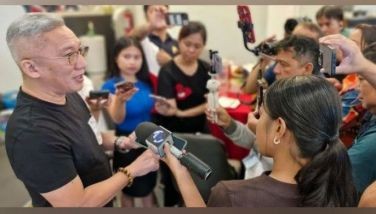Award-winning Cebuano artist receives congressional award
August 5, 2005 | 12:00am
Painter Romulo Galicano, a Carcar town resident who bagged the grand prize in the 2005 International Portrait Competition hosted by the Portrait Society of America in Washington, D.C, yesterday received the first Congressional Award for Excellence from Cebu first district Rep. Eduardo Gullas.
Before he handed over the plaque of recognition to Galicano, Gullas said Carcaranons should be proud of Galicano. "Ang atong lungsod dili bantugan sa ampaw ug chicharon, naa pud tay Filipino painter," Gullas said.
Following his arrival from Washington DC in May, Galicano received recognition from President Gloria Macapagal Arroyo in Malacañang for his rare achievement.
Galicano, 60, said his winning entry, a 30 x 40 oil painting portrait of Eddie Chua, a businessman and personal friend, was a perfect example of temporary realism - a fusion of realist and abstract art discipline. He bested 2,000 other painters from all over the world in this year's International Portrait Competition held on May 14.
"Do your best and be passionate," Galicano said in his speech during the ceremony held at the Carcar Sports Complex and attended by more than 100 students. Local chief executives of the first district also attended the ceremony.
Galicano is the second Filipino to win the contest after the legendary Juan Luna, whose winning piece, "Spolarium," painted 123 years ago.
Galicano found a natural interest in arts at a young age, producing sketches as a hobby. During his teens, he trained under his uncle, Martino Abellana, one of Cebu's top realist artists. He also imbibed the artistic discipline from Sugboanon painter Sofronio Mendoza.
Galicano grew up as the personal student of his uncle. The close relationship between the maestro and the student made Galicano the immediate heir to Abellana's artistic heritage.
In 1967, Galicano went to Manila to take up fine arts at the University of the East. Due to his solid training on figure drawing, well-known Manila artist Florencio Concepcion decided to teach him on abstract design.
All throughout 1968, Galicano had done expressionist works with spare elements. From 1969 to 1975, he underwent his impressionist period with the predominant influence of Abellana.
Before he handed over the plaque of recognition to Galicano, Gullas said Carcaranons should be proud of Galicano. "Ang atong lungsod dili bantugan sa ampaw ug chicharon, naa pud tay Filipino painter," Gullas said.
Following his arrival from Washington DC in May, Galicano received recognition from President Gloria Macapagal Arroyo in Malacañang for his rare achievement.
Galicano, 60, said his winning entry, a 30 x 40 oil painting portrait of Eddie Chua, a businessman and personal friend, was a perfect example of temporary realism - a fusion of realist and abstract art discipline. He bested 2,000 other painters from all over the world in this year's International Portrait Competition held on May 14.
"Do your best and be passionate," Galicano said in his speech during the ceremony held at the Carcar Sports Complex and attended by more than 100 students. Local chief executives of the first district also attended the ceremony.
Galicano is the second Filipino to win the contest after the legendary Juan Luna, whose winning piece, "Spolarium," painted 123 years ago.
Galicano found a natural interest in arts at a young age, producing sketches as a hobby. During his teens, he trained under his uncle, Martino Abellana, one of Cebu's top realist artists. He also imbibed the artistic discipline from Sugboanon painter Sofronio Mendoza.
Galicano grew up as the personal student of his uncle. The close relationship between the maestro and the student made Galicano the immediate heir to Abellana's artistic heritage.
In 1967, Galicano went to Manila to take up fine arts at the University of the East. Due to his solid training on figure drawing, well-known Manila artist Florencio Concepcion decided to teach him on abstract design.
All throughout 1968, Galicano had done expressionist works with spare elements. From 1969 to 1975, he underwent his impressionist period with the predominant influence of Abellana.
BrandSpace Articles
<
>
- Latest
- Trending
Trending
Latest






















